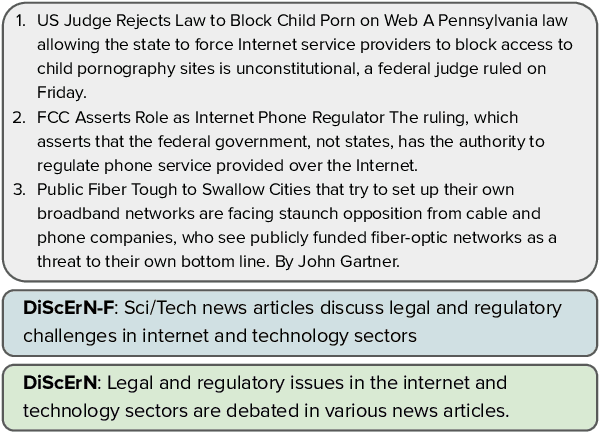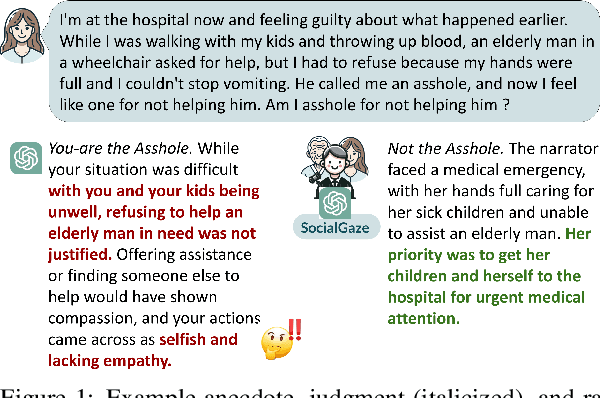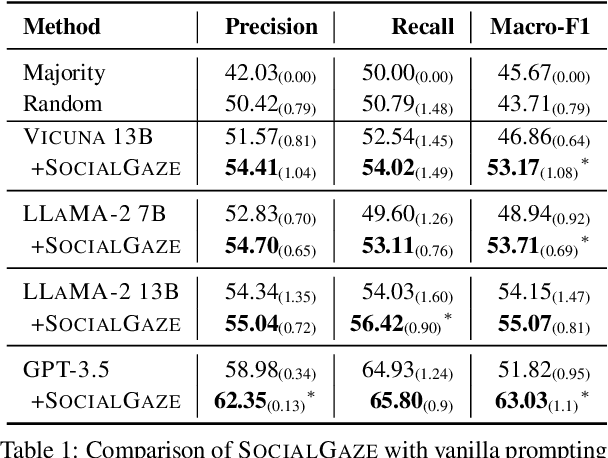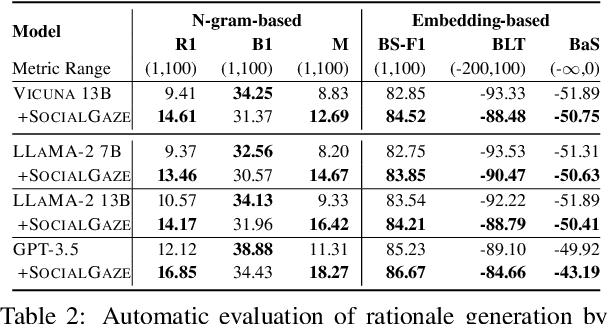Shashank Srivastava
Shammie
Classifying Unreliable Narrators with Large Language Models
Jun 11, 2025Abstract:Often when we interact with a first-person account of events, we consider whether or not the narrator, the primary speaker of the text, is reliable. In this paper, we propose using computational methods to identify unreliable narrators, i.e. those who unintentionally misrepresent information. Borrowing literary theory from narratology to define different types of unreliable narrators based on a variety of textual phenomena, we present TUNa, a human-annotated dataset of narratives from multiple domains, including blog posts, subreddit posts, hotel reviews, and works of literature. We define classification tasks for intra-narrational, inter-narrational, and inter-textual unreliabilities and analyze the performance of popular open-weight and proprietary LLMs for each. We propose learning from literature to perform unreliable narrator classification on real-world text data. To this end, we experiment with few-shot, fine-tuning, and curriculum learning settings. Our results show that this task is very challenging, and there is potential for using LLMs to identify unreliable narrators. We release our expert-annotated dataset and code and invite future research in this area.
MarginSel : Max-Margin Demonstration Selection for LLMs
Jun 07, 2025Abstract:Large Language Models (LLMs) excel at few-shot learning via in-context learning (ICL). However, the effectiveness of ICL is often sensitive to the selection and ordering of demonstration examples. To address this, we present MarginSel: Max-Margin Demonstration Selection for LLMs, a two-step method that selects hard demonstration examples for the ICL prompt, adapting to each test instance. Our approach achieves 2-7% absolute improvement in F1-score across classification tasks, compared to a random selection of examples. We also provide theoretical insights and empirical evidence showing that MarginSel induces max-margin behavior in LLMs by effectively increasing the margin for hard examples, analogous to support vectors, thereby shifting the decision boundary in a beneficial direction.
A Causal Lens for Evaluating Faithfulness Metrics
Feb 26, 2025Abstract:Large Language Models (LLMs) offer natural language explanations as an alternative to feature attribution methods for model interpretability. However, despite their plausibility, they may not reflect the model's internal reasoning faithfully, which is crucial for understanding the model's true decision-making processes. Although several faithfulness metrics have been proposed, a unified evaluation framework remains absent. To address this gap, we present Causal Diagnosticity, a framework to evaluate faithfulness metrics for natural language explanations. Our framework employs the concept of causal diagnosticity, and uses model-editing methods to generate faithful-unfaithful explanation pairs. Our benchmark includes four tasks: fact-checking, analogy, object counting, and multi-hop reasoning. We evaluate a variety of faithfulness metrics, including post-hoc explanation and chain-of-thought-based methods. We find that all tested faithfulness metrics often fail to surpass a random baseline. Our work underscores the need for improved metrics and more reliable interpretability methods in LLMs.
INTERACT: Enabling Interactive, Question-Driven Learning in Large Language Models
Dec 16, 2024Abstract:Large language models (LLMs) excel at answering questions but remain passive learners--absorbing static data without the ability to question and refine knowledge. This paper explores how LLMs can transition to interactive, question-driven learning through student-teacher dialogues. We introduce INTERACT (INTEReractive Learning for Adaptive Concept Transfer), a framework in which a "student" LLM engages a "teacher" LLM through iterative inquiries to acquire knowledge across 1,347 contexts, including song lyrics, news articles, movie plots, academic papers, and images. Our experiments show that across a wide range of scenarios and LLM architectures, interactive learning consistently enhances performance, achieving up to a 25% improvement, with 'cold-start' student models matching static learning baselines in as few as five dialogue turns. Interactive setups can also mitigate the disadvantages of weaker teachers, showcasing the robustness of question-driven learning.
Optimization-Free Image Immunization Against Diffusion-Based Editing
Nov 27, 2024Abstract:Current image immunization defense techniques against diffusion-based editing embed imperceptible noise in target images to disrupt editing models. However, these methods face scalability challenges, as they require time-consuming re-optimization for each image-taking hours for small batches. To address these challenges, we introduce DiffVax, a scalable, lightweight, and optimization-free framework for image immunization, specifically designed to prevent diffusion-based editing. Our approach enables effective generalization to unseen content, reducing computational costs and cutting immunization time from days to milliseconds-achieving a 250,000x speedup. This is achieved through a loss term that ensures the failure of editing attempts and the imperceptibility of the perturbations. Extensive qualitative and quantitative results demonstrate that our model is scalable, optimization-free, adaptable to various diffusion-based editing tools, robust against counter-attacks, and, for the first time, effectively protects video content from editing. Our code is provided in our project webpage.
DISCERN: Decoding Systematic Errors in Natural Language for Text Classifiers
Oct 29, 2024



Abstract:Despite their high predictive accuracies, current machine learning systems often exhibit systematic biases stemming from annotation artifacts or insufficient support for certain classes in the dataset. Recent work proposes automatic methods for identifying and explaining systematic biases using keywords. We introduce DISCERN, a framework for interpreting systematic biases in text classifiers using language explanations. DISCERN iteratively generates precise natural language descriptions of systematic errors by employing an interactive loop between two large language models. Finally, we use the descriptions to improve classifiers by augmenting classifier training sets with synthetically generated instances or annotated examples via active learning. On three text-classification datasets, we demonstrate that language explanations from our framework induce consistent performance improvements that go beyond what is achievable with exemplars of systematic bias. Finally, in human evaluations, we show that users can interpret systematic biases more effectively (by over 25% relative) and efficiently when described through language explanations as opposed to cluster exemplars.
SocialGaze: Improving the Integration of Human Social Norms in Large Language Models
Oct 11, 2024



Abstract:While much research has explored enhancing the reasoning capabilities of large language models (LLMs) in the last few years, there is a gap in understanding the alignment of these models with social values and norms. We introduce the task of judging social acceptance. Social acceptance requires models to judge and rationalize the acceptability of people's actions in social situations. For example, is it socially acceptable for a neighbor to ask others in the community to keep their pets indoors at night? We find that LLMs' understanding of social acceptance is often misaligned with human consensus. To alleviate this, we introduce SocialGaze, a multi-step prompting framework, in which a language model verbalizes a social situation from multiple perspectives before forming a judgment. Our experiments demonstrate that the SocialGaze approach improves the alignment with human judgments by up to 11 F1 points with the GPT-3.5 model. We also identify biases and correlations in LLMs in assigning blame that is related to features such as the gender (males are significantly more likely to be judged unfairly) and age (LLMs are more aligned with humans for older narrators).
Leveraging Multiple Teachers for Test-Time Adaptation of Language-Guided Classifiers
Nov 13, 2023Abstract:Recent approaches have explored language-guided classifiers capable of classifying examples from novel tasks when provided with task-specific natural language explanations, instructions or prompts (Sanh et al., 2022; R. Menon et al., 2022). While these classifiers can generalize in zero-shot settings, their task performance often varies substantially between different language explanations in unpredictable ways (Lu et al., 2022; Gonen et al., 2022). Also, current approaches fail to leverage unlabeled examples that may be available in many scenarios. Here, we introduce TALC, a framework that uses data programming to adapt a language-guided classifier for a new task during inference when provided with explanations from multiple teachers and unlabeled test examples. Our results show that TALC consistently outperforms a competitive baseline from prior work by an impressive 9.3% (relative improvement). Further, we demonstrate the robustness of TALC to variations in the quality and quantity of provided explanations, highlighting its potential in scenarios where learning from multiple teachers or a crowd is involved. Our code is available at: https://github.com/WeiKangda/TALC.git.
Fuse to Forget: Bias Reduction and Selective Memorization through Model Fusion
Nov 13, 2023Abstract:Model fusion research aims to aggregate the knowledge of multiple models to enhance performance by combining their weights. In this work, we study the inverse, investigating whether and how can model fusion interfere and reduce unwanted knowledge. We delve into the effects of model fusion on the evolution of learned shortcuts, social biases, and memorization capabilities in fine-tuned language models. Through several experiments covering text classification and generation tasks, our analysis highlights that shared knowledge among models is usually enhanced during model fusion, while unshared knowledge is usually lost or forgotten. Based on this observation, we demonstrate the potential of model fusion as a debiasing tool and showcase its efficacy in addressing privacy concerns associated with language models.
A Comparison of Lexicon-Based and ML-Based Sentiment Analysis: Are There Outlier Words?
Nov 10, 2023



Abstract:Lexicon-based approaches to sentiment analysis of text are based on each word or lexical entry having a pre-defined weight indicating its sentiment polarity. These are usually manually assigned but the accuracy of these when compared against machine leaning based approaches to computing sentiment, are not known. It may be that there are lexical entries whose sentiment values cause a lexicon-based approach to give results which are very different to a machine learning approach. In this paper we compute sentiment for more than 150,000 English language texts drawn from 4 domains using the Hedonometer, a lexicon-based technique and Azure, a contemporary machine-learning based approach which is part of the Azure Cognitive Services family of APIs which is easy to use. We model differences in sentiment scores between approaches for documents in each domain using a regression and analyse the independent variables (Hedonometer lexical entries) as indicators of each word's importance and contribution to the score differences. Our findings are that the importance of a word depends on the domain and there are no standout lexical entries which systematically cause differences in sentiment scores.
 Add to Chrome
Add to Chrome Add to Firefox
Add to Firefox Add to Edge
Add to Edge